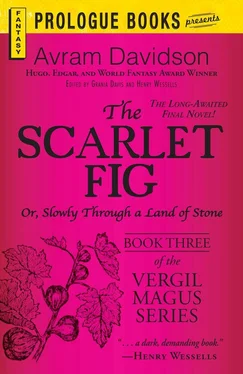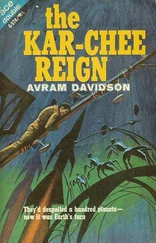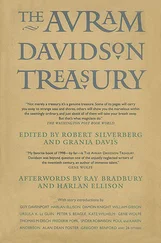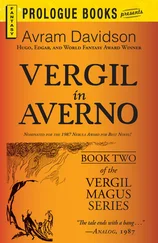
The Scarlet Fig
Or, Slowly Through a Land of Stone,
Book Three of the Vergil Magus Series
by
Avram Davidson
THE SCARLET FIG is the third and last Vergil Magus novel to come from Avram Davidson’s pen. It is steeped in the millieu of its predecessor works, The Phoenix And The Mirror and Vergil In Averno, and — perhaps more comprehensively than any other of his works — in the knowledge, lore, mysteries and other enquiries that engaged Avram’s mind in the production of his magnum opus.
As Avram explained in his introduction to The Phoenix and the Mirror: “From the Dark Ages to the Renascence the popular view of the ancient world as reflected in the Vergilean Legends was far from the historical and actual one in more than the acceptance of legend and magic and myth. It is a world of never-never, and yet it is a world true to its own curious lights — a backward projection of medievalism, an awed and confused transmogrification of quasi-forgotten ancient science.”
This process of transmogrification takes place in THE SCARLET FIG in endlessly inventive ways; in the substitution of SQPR for SPQR, in the conflation of the two Diomedes (of Argos and of Thrace) into a single figure, in the delightful neologism of Byzantinople.
The ancients held the world to be immersed in a “universal aether”, a sea of knowledge. Avram too existed in just such an aether: into this sea he would dip his nets and draw up the strangest of fish, and set them gently before his readers. One manifestation of this was the vast card files that Avram established to support his Vergil sequence (and for which Avram employed the working title The Encyclopaedia of the World of Vergil Magus ), copiously cross-referenced, full of tangential connections and cryptic references across a huge array of source texts. A selection of these cards are reproduced in an appendix to this volume and they demonstrate the scale of Avram’s ambition for the Vergil sequence.
Drawing from this unique resource, THE SCARLET FIG teems with all manner of wonders and strange notions, all vividly rendered: Castor and Pollux, harpies, basilisks, the satyr-infested Isle of the Lotophages, Sindibaldo, the origins of perspective, Phoenician dyes, the derivation of that most Dutch of birds — the Flemingoe, the magical powers of wand and twig (also known as virga , a play on Virgil in Latin).
THE SCARLET FIG is in many ways a paean to the love of knowledge, of pure knowledge, the knowledge which gives meaning and context to our world. Vergil’s world is experienced as much through the gaining and giving — the interchange — of knowledge as it is experienced through Vergil’s physical journeying, adventures and sensations. This happy marriage of the intellect and the senses, viewed through the looking glass of “unhistory”, makes the THE SCARLET FIG one of the finest expressions of Avram Davidson’s art.
Phillip Rose London, England.
I
Yellow Rome; or, Vergil and the Vestal Virgin
In Rome Yellow Rome! Yellow Rome! — a man was being led to public execution. Aristocrats might be quietly and secretly slain, but this was no aristocrat. Some common thug, a street-robber by night, or a house-breaker, thick and shambling, ill-made and ill-looking, he had killed a cobbler’s apprentice for a stiver — the smallest coin. The lictor went first, carrying the bundle of rods which might be used to flog the criminal (but wouldn’t) wrapped around the single-edged axe which might be used to cut off his head (but wouldn’t). It was a symbol only, and the lictor looked bored and disdainful. Next, arms bound behind him at the elbows, legs hobbled with ropes, the felon stumbled, followed, between two files of soldiers. Grasping him fast by a noose round his neck came the common hangman: one might have had them change clothes and places and scarcely told them apart.
“Well, ‘one Vergil, a natural of Rome, and no mere denizen,’ do they have anything to do with this in Naples … I say nothing of the Bail of Brundisy …?” The wauling was Quint’s, to be heard above the clamor of the throng. There was in his voice some light and affectionate taunt that Vergil had not been born in the City itself but nearer to where he now lived by the great Voe of Naples than to Yellow Rome itself. The so-well-paved Appian Way went straight and strait between Yellow Rome and Brundisy, but there branched off a branch of it for Naples. A young mage, not yet very well-established in his profession (or in public fame) did well to travel now and then to the Imperial capital, and gently press the thought that there was one (himself) useful to be friend of a friend (Quint) with a friend (the rich Etruscan) to the court Imperial, to the Oliphaunt Throne … not to be lightly named: whomsoever sate upon it.
Vergil pressed his bearded lips to Quint’s smooth ear-hole, said loud and sharp, throngs and thugs, all right: but neither one was anything to this particular display.
The throng howled, as the throng always would.
“ Chin up, cock! Brave it out! ”
“ They’ll stretch that short neck! ”
“ Hang the hangman! A louse for the hangman! ”
“ You’ll scrag no more widdies nor prentices! ”
“ Up tails all! ”
“ Die! For a lousy stiver? Die! Die with a hard club, die! ”
The wretch’s face changed expression, but it changed slowly: now he had the sly look of a pig who had broken into a pea-patch, now he was pleased at the attention, now he scowled as some thick and gross insult struck home, now he looked desperately from side to side; always the hangy forced him on, as close to him as the butcher to the ox. All this passed before Vergil and before Quint, and they stood and looked on; Vergil was Quint’s guest, and Quint was the guest of Someone Important in Yellow Rome. Even a wizard, even if he did not want wealth, was willing to draw near to wealth, if he were young and new and scarcely known. And near to power, even if that sort of power he did not much want. Soon enough this procession would pass by, and then they would cross, cross safely on foot, for in Rome (and in Rome alone) no wheeled vehicle might pass through the streets in the day time.
In that case, in a sudden silence, what hooves were those, and what wheels? Quint, that Roman of Romans, knew at once: and would tell Vergil soon enough … if he did not ask. The mob broke into noise again, its inalienable right, and though it was still shouting, it seemed to be shouting the same something, though not all at the same time. Half the yammering throng faced the nice little wagonette and its nice little mule, and the woman, half-veiled, who was in it. Her small slave-girl holding the sea-silk sunshade or ombello was beginning to be inattentive a bit and a bit the sunshade slipped.
And half the vulgus faced the procession and shouted and gestured, pointing, pointing —
The lictor had strode on, eyes down; and in fact by then he had gotten ahead of the procession and seemed rather to have forgotten it: lictors, too, have their secret private thoughts.
The soldiery slogged along in its fixed rhythms, paying no attention at all to the thing its ranks confined; probably thinking of the evening’s rations: bread, salt, garlic, parsley (growing in ruins and waste places, rank as weeds), wine, perhaps a bit of dried meat or a bit of dried fish — tunny harpooned in the bloody trapping pens, for instance, “from the rise of the rainy Pleiades [1] Some say “the rainy Hyades ,” by Pleiades , sayeth The Matter: and further The Matter sayeth not.
to the setting of bright Arcturus” — and the anticipated meal with its perhaps, treat, meant far more to them than any execution of a sentence of death. Death, to an old soldier, was more boring than exciting.
Читать дальше












